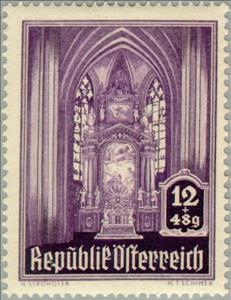Stamp: Baroque high altar before destruction in 1945 (Austria 1946)
Baroque high altar before destruction in 1945 (Austria 1946)
12 December (Austria ) within release Rebuilding Stephan's Cathedral, Vienna goes into circulation Stamp Baroque high altar before destruction in 1945 face value 12+48 Austrian groschen
| Stamp Baroque high altar before destruction in 1945 in catalogues | |
|---|---|
| Michel: | Mi:AT 796 |
| Yvert et Tellier: | Yt:AT 658 |
Stamp is vertical format.
Also in the issue Rebuilding Stephan's Cathedral, Vienna:
- Stamp - Duke Rudolf IV (1339-65) founder of the cathedral face value 3+12;
- Stamp - Tomb of Emperor Friedrich III (1415-93) face value 5+20;
- Stamp - Pulpit of Anton Pilgram (16th Cty.) face value 6+24;
- Stamp - St. Stephan (giant gate), 15th Cty. face value 8+32;
- Stamp - Servant's Madonna, Barbara Chapel in the cathedral face value 10+40;
- Stamp - Baroque high altar before destruction in 1945 face value 12+48;
- Stamp - Baroque organ in the West Gallery (destroyed 1945) face value 30+120;
- Stamp - Master Anton Pilgram (16th Cty.) self portrait face value 50+180;
- Stamp - North Tower of the cathedral face value 1+5;
- Stamp - South Tower of the cathedral face value 2+10;
Stamp Baroque high altar before destruction in 1945 it reflects the thematic directions:
Sculpture is the branch of the visual arts that operates in three dimensions. Sculpture is the three-dimensional art work which is physically presented in the dimensions of height, width and depth. It is one of the plastic arts. Durable sculptural processes originally used carving (the removal of material) and modelling (the addition of material, as clay), in stone, metal, ceramics, wood and other materials but, since Modernism, there has been almost complete freedom of materials and process. A wide variety of materials may be worked by removal such as carving, assembled by welding or modelling, or moulded or cast.
he Baroque or Baroquism is a Western style of architecture, music, dance, painting, sculpture, poetry, and other arts that flourished from the early 17th century until the 1750s. It followed Renaissance art and Mannerism and preceded the Rococo (in the past often referred to as "late Baroque") and Neoclassical styles. It was encouraged by the Catholic Church as a means to counter the simplicity and austerity of Protestant architecture, art, and music, though Lutheran Baroque art developed in parts of Europe as well
A church building, often simply called a church, is a building used for Christian religious activities, particularly worship services. The term in its architectural sense is most often used by Christians to refer to their religious buildings, but it is sometimes used (by analogy) for buildings of other religions. In traditional Christian architecture, the church is often arranged in the shape of a Christian cross. When viewed from plan view the longest part of a cross is represented by the aisle and the junction of the cross is located at the altar area. Towers or domes are often added with the intention of directing the eye of the viewer towards the heavens and inspiring church visitors. Modern church buildings have a variety of architectural styles and layouts; many buildings that were designed for other purposes have now been converted for church use; and, similarly, many original church buildings have been put to other uses. The earliest identified Christian church was a house church founded between 233 and 256. During the 11th through 14th centuries, a wave of building of cathedrals and smaller parish churches occurred across Western Europe. A cathedral is a church, usually Roman Catholic, Anglican, Oriental Orthodox or Eastern Orthodox, housing the seat of a bishop.


